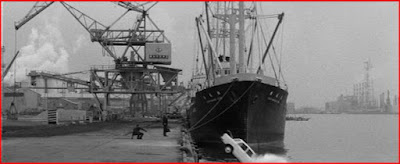 Takashi Nomura's thriller is nine years removed from I Am Waiting, the first film in Criterion Eclipse's Nikkatsu Noir collection. In those years the "borderless" genre inevitably, even purposefully absorbed influences from new genres around the world. The liner notes acknowledge the most obvious influence, the one we can hear in Harumi Ibe's music -- the influence of Ennio Morricone and his peers in the spaghetti western genre. The final showdown between Joe Shishido and his enemies in a desert-like landscape is probably partly spaghetti-inspired as well. But to my eyes the Italian influence doesn't end there. Nomura proves himself a widescreen master here, and the way he films architecture and landscape, especially when he emphasizes empty space or the absence of people or objects, reminds me more of Michelangelo Antonioni than of Sergio Leone.
Takashi Nomura's thriller is nine years removed from I Am Waiting, the first film in Criterion Eclipse's Nikkatsu Noir collection. In those years the "borderless" genre inevitably, even purposefully absorbed influences from new genres around the world. The liner notes acknowledge the most obvious influence, the one we can hear in Harumi Ibe's music -- the influence of Ennio Morricone and his peers in the spaghetti western genre. The final showdown between Joe Shishido and his enemies in a desert-like landscape is probably partly spaghetti-inspired as well. But to my eyes the Italian influence doesn't end there. Nomura proves himself a widescreen master here, and the way he films architecture and landscape, especially when he emphasizes empty space or the absence of people or objects, reminds me more of Michelangelo Antonioni than of Sergio Leone.Nomura gives Colt an imposing sense of vastness, but still keeps the focus on Joe Shishido as the archetypal hard-boiled anithero.
Nomura's approach results in some uncanny moments. The film opens with Shishido, a hitman, being shown the daily itinerary of his newest target. We get a sequence of the target's car pulling out of his driveway, then arriving at his office. The we cut to the man inside his office, his bodyguard at his side, and the camera pulls back majestically to show Shishido and his handler casing the scene from across the street. Nomura repeats the same sequence a few minutes later, holding each shot long enough to show us that Shishido isn't following the target or staking him out where we expect him. The director dramatizes Shishido's absence, making us wonder where he is until we see how the hitman will solve the problem of reaching his target in a way his employer can easily verify. Another brilliantly shot scene shows one gangster in a car trying to shake a tail. We see the action from the back of the gangster's car as he accelerates and the tail car disappears around a hillside. Nomura holds the shot for nearly a minute as the car keeps going until the tail car suddenly reappears.
The final showdown shows that Nomura isn't just a clever choreographer of non-action. But where the spaghetti directors emphasized close-ups, Nomura's showdown is all about long shots that emphasize the wide-open landscape and Shishido's almost hopeless vulnerability. After a lengthy buildup as Shishido prepares his ground for who knows what (it involves some TNT and digging what might be a foxhole or a grave), the scene explodes into rapid-fire cutting and a remarkable tracking shot as Shishido runs from left to right across a line of enemies, dodging bullets, switching weapons and blasting away.
Colt is easily the most ingeniously directed of the Nikkatsu Noirs, but the story is still basic crime cinema. Shishido's hitman is hired by one crime family to kill the head of another, but he does so in a way that puts too much heat on his employers initially. Worse for him, the families are quite quickly reconciled, on the condition that Shishido pay with his life, a pawn to be sacrificed. The rest of the film is his attempt to flee Japan (tying in to the "new start" theme of many of these films), or at least facilitate the escape of his sidekick and a waitress who's befriended them. The sidekick or protege is an unwelcome touch, since the actor Jerry Fujio seems to be in the movie only to sing a song and remind us that Japan could well have gone the way of Bollywood if some things had changed. But that's probably the only unwelcome touch in this terrific genre film. It's not as emotionally complex as I Am Waiting or Rusty Knife with their mirror-plots, but as pure entertainment and in especially in visual terms it's arguably the best of the Nikkatsu Noir set.
The no-frills nature of the Eclipse series means no trailers for the films. ctcasey has made up for that by uploading the A Colt is My Passport trailer to YouTube. The film's really a lot less crass that the pulpy ballyhoo of the trailer suggests.







No comments:
Post a Comment